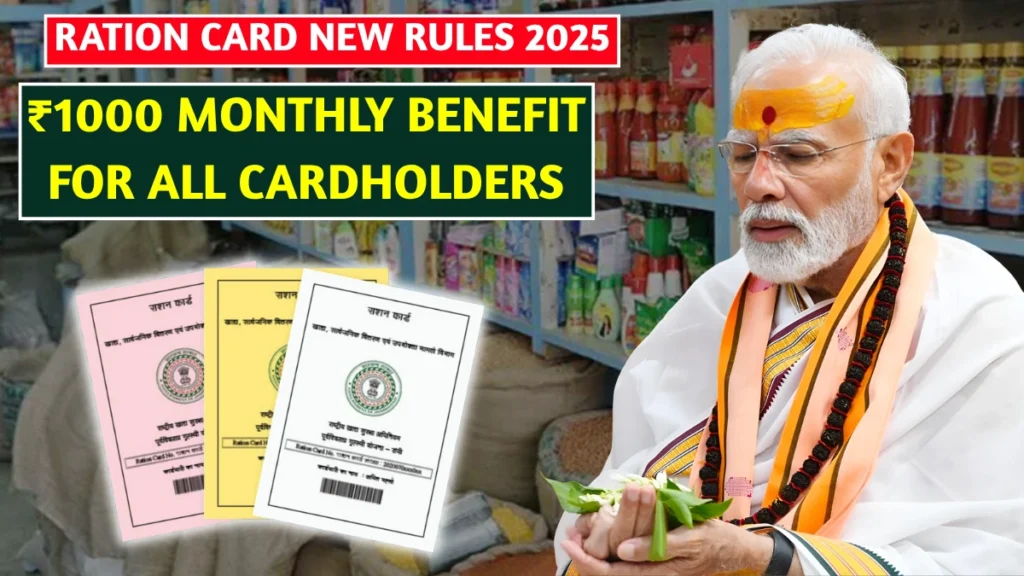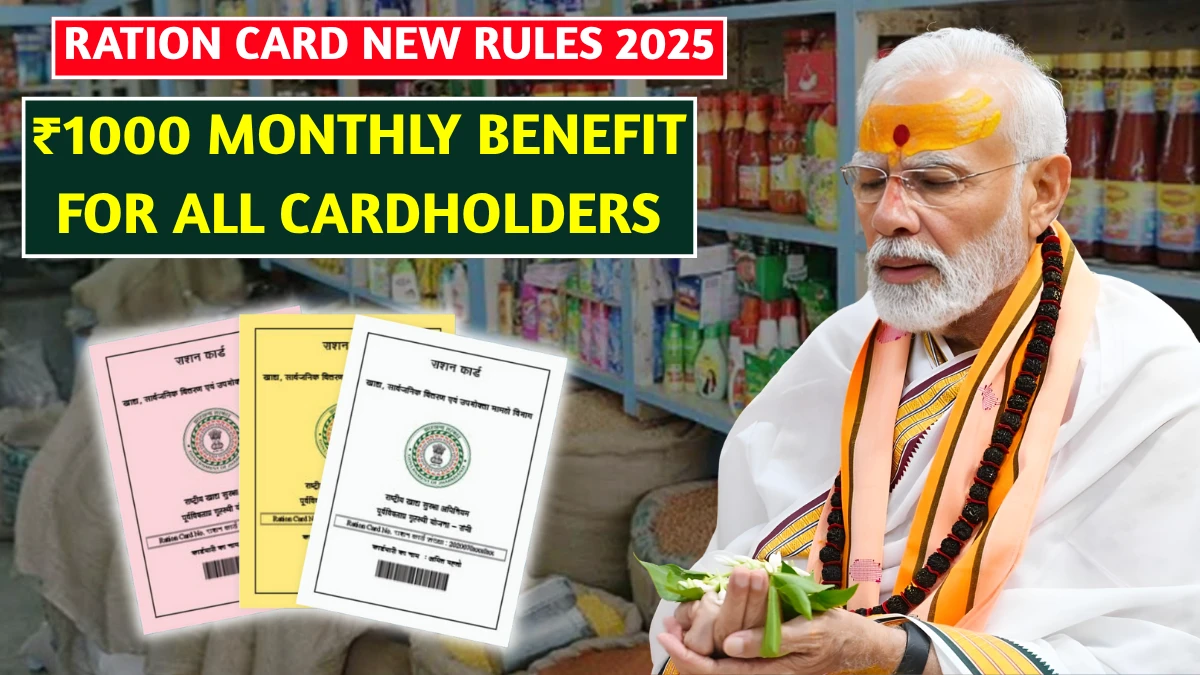Ration Card New Rules 2025: In 2025, the government has introduced new guidelines to enhance the benefits for ration cardholders across the country. These changes aim to improve the access to essential goods and services for those who need it the most.
One of the major highlights of the new rules is the ₹1000 monthly benefit for all ration cardholders. This initiative is expected to support low-income households, providing them with a financial cushion to help with everyday expenses. Below, we will dive deeper into what these new rules entail, how they work, and who stands to benefit from them.

What is the ₹1000 Monthly Benefit?
The ₹1000 monthly benefit is a new scheme designed to offer financial assistance to all ration cardholders. Under this new initiative, every family holding a valid ration card will receive ₹1000 every month. This amount can be used for various purposes such as purchasing groceries, medicines, or other essentials that fall outside the scope of the subsidized food items provided under the Public Distribution System (PDS). The aim of this benefit is to provide extra support to families who are struggling to make ends meet due to inflation and rising living costs.
Why is this Benefit Being Introduced?
The introduction of this ₹1000 monthly benefit is part of the government’s ongoing efforts to address poverty and improve the welfare of the lower-income groups. With the rising prices of essential goods, especially food and fuel, many families in rural and urban areas have been finding it increasingly difficult to afford basic necessities. While the PDS has helped millions by providing subsidized food grains, it does not cover other critical needs. This ₹1000 benefit seeks to fill that gap, ensuring that people have a little extra financial support to manage their everyday challenges.
Who is Eligible for the Benefit?
Any individual or family holding a valid ration card will be eligible for the ₹1000 monthly benefit. This includes both Antyodaya Anna Yojana (AAY) cardholders and Below Poverty Line (BPL) cardholders. In fact, even families with Above Poverty Line (APL) cards are now eligible to receive this assistance. The criteria for ration card distribution are based on income levels and socio-economic factors. However, the introduction of this benefit ensures that the majority of households across the country, irrespective of their income level, will benefit from this scheme.
How Will the ₹1000 Benefit Be Distributed?
The ₹1000 monthly benefit will be directly credited to the bank accounts of eligible cardholders. The government plans to implement a seamless digital transfer process to ensure that the money reaches the beneficiaries without delay. In cases where individuals do not have a bank account, alternative arrangements will be made, such as linking their Aadhaar with the ration card or providing a cash transfer through other means. This will help avoid any bottlenecks in distribution and ensure that everyone who qualifies for the benefit receives it on time.
What Can the ₹1000 Be Used For?
Unlike the PDS system, which primarily offers food grains and other essential food items at subsidized rates, the ₹1000 monthly benefit can be used for a wide range of purposes. Cardholders will be free to use this money to purchase essential goods that are not covered by the ration card. This could include hygiene products, medicines, vegetables, cooking oil, and even transportation costs. The goal is to give families the flexibility to meet their specific needs, allowing them to prioritize what is most important for their well-being.
Impact on Low-Income Families
The ₹1000 benefit is expected to make a significant difference in the lives of low-income families. For many households, this additional financial support could help cover the gap between income and expenditure. Families that are already struggling with the rising cost of living will now have some extra breathing room. This initiative is expected to reduce the burden on such families and improve their overall quality of life by providing them with more purchasing power and access to essential services.
Expected Challenges in Implementation
While the ₹1000 monthly benefit is a much-needed relief for many, there are likely to be challenges in implementing the scheme. The biggest hurdle will be ensuring that the distribution process is smooth and that the financial assistance reaches the intended beneficiaries without any delays. The government will need to ensure that all ration cardholders have access to a bank account or another method of receiving the funds. Additionally, there may be concerns about fraud or misuse of the system, which the government will need to address through robust monitoring and enforcement.
Government’s Plan for Efficient Distribution
To overcome these challenges, the government is already working on a detailed plan to ensure efficient distribution. The plan involves using digital platforms to verify beneficiaries and streamline the payment process. Aadhar-based authentication will be a key tool in ensuring that only legitimate cardholders benefit from the scheme. In addition, the government is investing in infrastructure and technology to ensure that there are no bottlenecks in the system.
How Will This Benefit Help the Economy?
In the long run, the ₹1000 benefit could have positive effects on the national economy as well. By increasing the disposable income of low-income families, the government is likely to stimulate local consumption. This could, in turn, boost demand for goods and services, providing a much-needed push to the economy. The increase in consumer spending may also help small businesses, especially in rural and semi-urban areas, where a large portion of the population relies on daily wages and small-scale trades.
Conclusion: A Step Towards Welfare for All
The introduction of the ₹1000 monthly benefit for ration cardholders is a bold step by the government to provide additional financial support to the lower-income population. By ensuring that all cardholders, irrespective of their income level, receive this benefit, the government is helping to reduce the financial stress faced by millions of families. As the scheme is rolled out across the country, it has the potential to significantly improve the living standards of vulnerable populations, offering them a better chance at a more secure and comfortable life.
In conclusion, the ₹1000 monthly benefit under the new Ration Card Rules 2025 is not just a financial aid; it is a sign of the government’s commitment to supporting the most vulnerable segments of society. It may not solve all economic challenges, but it will certainly provide a much-needed buffer for many households.
Disclaimer
The information provided in this article is for general informational purposes only. While every effort has been made to ensure the accuracy of the details presented, the details regarding the ₹1000 monthly benefit for ration cardholders in 2025 are subject to official government notifications and may change. Readers are encouraged to verify the latest updates from official sources or government websites before making any decisions based on this content. The author and the platform do not accept any liability for any discrepancies or consequences resulting from the use of the information provided here.
